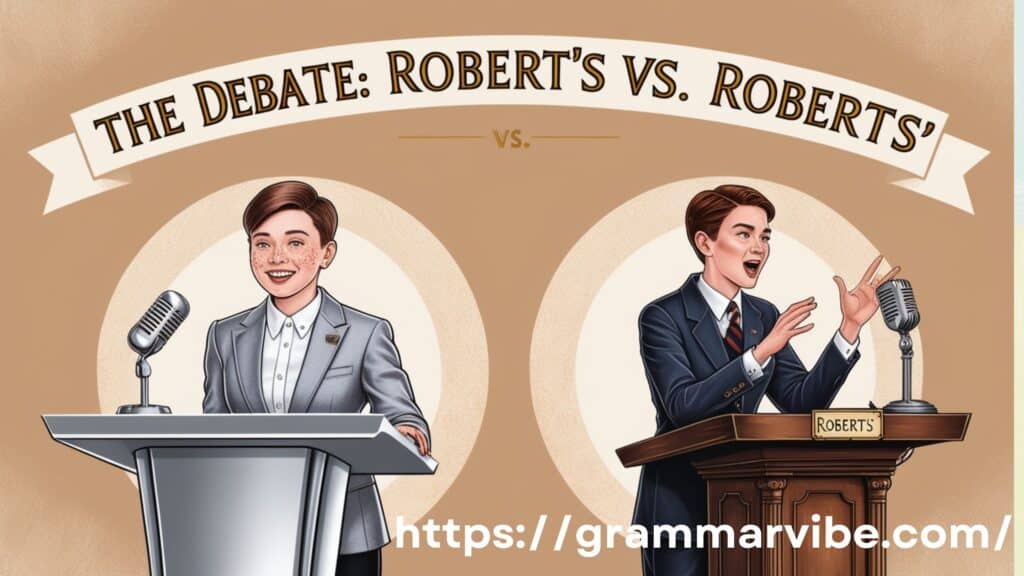When it comes to forming possessives in English, names ending in s can lead to confusion. The names Roberts presents such a dilemma: should it be Roberts’ or Roberts’s? Understanding the nuances of possessive forms can help you write clearly and confidently.
This article explores these variations, providing examples and guidance based on established style guides. Both forms convey ownership, but understanding when to use each can elevate your writing and keep it consistent.
The Basics of Possessives
Before diving into the specifics of Roberts and its possessive forms, let’s establish what we mean by possessives. A possessive form indicates ownership or association. For instance, when you say, “This is Roberts’s book,” you’re communicating that the book belongs to Roberts.
Check out this: Client’s or Clients’ or Clients
Singular Form of Roberts
The singular form of Roberts refers simply to the name itself. For example, “Roberts is giving a speech.” When you want to indicate possession, you’ll modify the name into its possessive form.
Singular Possessive Forms
The possessive form of Roberts can be constructed in two ways:
- Roberts’s (with an additional s)
- Roberts’ (without an additional s)
For your interest: Today’s or Todays
The Debate: Roberts’s vs. Roberts’

Roberts’s
The form Roberts’s is widely accepted and is often the preferred option in formal writing. This version emphasizes ownership and aligns with traditional grammar rules, particularly those outlined in the Chicago Manual of Style.
Example Sentences:
- Roberts’s leadership skills are evident in his project management style.
- I attended Roberts’s seminar on effective communication.
Using Roberts’s avoids any ambiguity about possession, making it clear that the items or qualities belong to Roberts.
Roberts’
On the other hand, the form Roberts’ omits the additional s. This option is commonly used in the AP Style guidelines, particularly when the next word begins with an s.
Example Sentences:
- Roberts’ presentation was insightful and engaging.
- The team praised Roberts’ ability to connect with the audience.
Using Roberts’ helps to prevent the awkwardness of having multiple s sounds in succession, which can sometimes disrupt the flow of reading.
Explore further: Months or Month’s
Consistency in Possessives
Whichever form you choose—Roberts’s or Roberts’—consistency is key. It’s essential to stick with one version throughout your writing to maintain clarity and avoid confusion. For instance, if you start with Roberts’s, don’t switch to Roberts’ halfway through your document.
Related content: Thomas’ or Thomas’s
Style Guide Recommendations
Different style guides offer varying recommendations on possessive forms. Here’s a quick overview:
- Chicago Manual of Style: Advocates for using Roberts’s.
- AP Style: Recommends Roberts’, especially to ease pronunciation.
By knowing which style guide you’re following, you can choose the appropriate possessive form of Roberts.
Recommended reading: Doctor’s or Doctors’
Possession in Names: Contextual Examples

Let’s look at some scenarios to better understand the usage of Roberts’s and Roberts’ in different contexts.
Scenario 1: Leadership Context
Imagine a corporate setting where Roberts is a manager leading a project.
- Roberts’s vision for the project inspired the team to exceed their goals.
- Everyone appreciates Roberts’ innovative strategies, which have led to remarkable results.
In this case, either possessive form works, but the choice may depend on the style guide you’re adhering to.
Scenario 2: Humor and Personality
Consider a casual conversation about Roberts’ personality.
- Roberts’ sense of humor always lightens the mood during meetings.
- His jokes are part of Roberts’s charm.
Here, using Roberts’ prevents the awkward repetition of the s sound, making the phrase smoother.
Scenario 3: Academic Writing
In academic writing, clarity is essential.
- Roberts’s research on social dynamics has garnered significant attention.
- Roberts’ conclusions about human behavior offer new insights.
Both forms can be used, but depending on your audience and the style guide, one may be more appropriate.
For your interest: Other Ways to Say “Thank You for Responding Quickly”
Grammar Rules for Possessives

Understanding the grammar rules for possessives can enhance your writing clarity. Here are some key points to remember:
- Add an apostrophe and an s for singular nouns (e.g., Roberts’s).
- For plural nouns ending in s, add just an apostrophe (e.g., the Roberts’ meeting).
- For singular nouns that do not end in s, also add an apostrophe and an s (e.g., James’s book).
Check out this: Lucas’s or Lucas’
Common Mistakes to Avoid
Even seasoned writers can stumble on possessive forms. Here are a few common pitfalls:
- Inconsistent usage: Switching between Roberts’s and Roberts’ in the same text can confuse readers.
- Overusing possessives: While it’s essential to show possession, overusing possessive forms can clutter your writing.
- Ignoring style guidelines: Familiarize yourself with the style guide you’re using to ensure adherence to specific rules.
Summary: Choosing the Right Form
So, which is correct—Roberts’s or Roberts’? The answer is that both are acceptable, but context and style guide preferences will dictate your choice.
- **Use *Roberts’s* for a formal, traditional approach, especially in academic writing.
- **Opt for *Roberts’* in journalistic writing or when clarity in pronunciation is a concern.
Final Thoughts

Mastering possessive forms, particularly with names like Roberts, enhances your writing’s clarity and professionalism. Remember to choose a form, stick with it, and ensure consistency throughout your document. With practice and attention to detail, you’ll convey possession confidently and effectively.
This exploration of Roberts’s and Roberts’ provides the framework to navigate possessive forms with ease. Whether you’re drafting an email, a report, or an article, understanding these rules will help you communicate more clearly. Keep practicing, and you’ll soon find that using possessives becomes second nature!
Table summarizing the possessive forms of Roberts :
| Form | Example Sentence |
|---|---|
| Singular | Roberts |
| Singular Possessive | Roberts’s office is on the top floor. |
| Roberts’ proposal was accepted. | |
| Both forms are correct; choose based on style. | |
| Chicago Manual of Style prefers Roberts’s. | |
| AP Style allows Roberts’ for smoother reading. | |
| Consistency is key; choose one form and stick to it. |

Kyren Paul is an experienced blogger and the creative mind behind “Grammar Vibe.” With a passion for the nuances of English grammar, he brings clarity and insight to everyday language topics, making grammar accessible and engaging for readers of all levels.











Leave a Comment